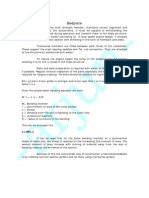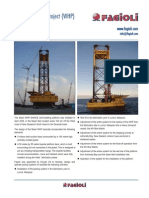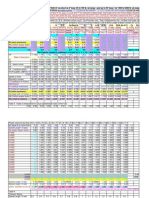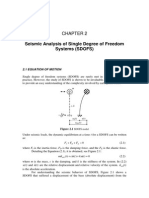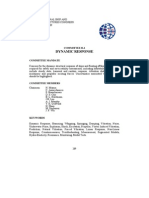Model Building
Model Building
Uploaded by
Jamhari MustofaCopyright:
Available Formats
Model Building
Model Building
Uploaded by
Jamhari MustofaOriginal Title
Copyright
Available Formats
Share this document
Did you find this document useful?
Is this content inappropriate?
Copyright:
Available Formats
Model Building
Model Building
Uploaded by
Jamhari MustofaCopyright:
Available Formats
www.orcina.
com
OrcaFlex Training Exercises
As part of the OrcaFlex introductory training course, three short ‘assignments’ are provided here
for completion by the trainee. These assignments are simply intended to provide some hands-on
experience of using the OrcaFlex software, they are not intended to represent real offshore
systems. You can choose which one you would like to model.
1 Mid Water Arch
This example considers creating a mid-water arch model.
1.1 System Configuration
Four lines are laid in a “lazy S” configuration over a mid-water arch in a water depth of 120m. The
basic configuration of the system is shown in the following sketch.
Figure 1-1: Basic Lazy ‘S’ Configuration
The default OrcaFlex vessel can be used to model the FPSO.
The arch has a mass of 50te and has the following geometry:
Figure 1-2: Arch Geometry
Model building.docx, 08/03/2023 14:06 Page 1 of 6
www.orcina.com
The tethers restraining the arch should be configured so that the arch sits approximately mid-
water (i.e. 60m depth).
There are two tethers systems; one at either end of the arch, as shown in Figure 2-2 Each ‘tether
system’ is composed of a vertical tether extending from the seabed to just below the arch and two
short bridles (each 4m in length) then form the connection between the top of each vertical tether
and the arch itself – see Figure 2-2.
The vertical tethers are constructed from 75mm nominal diameter ‘wire with wire core’ rope. (The
line type wizard can be used to create the tether roper properties). Connecting each vertical tether
to the arch itself are two short bridles lines. For modelling purposes, these can be assumed to
have the same properties as the main tethers.
There are four risers going over the arch. These have the following properties.
Table 1.1: Riser Properties
The two outermost lines are filled with gas (same density as air), the two inner lines are flooded
with seawater.
The lines exit the FPSO on its starboard side, as shown in the following sketch. All four lines have
1.5m separation as they exit the FPSO. The separation between the lines as they pass over the
arch is also 1.5m. The riser connection to the FPSO can be assumed to be pinned.
Figure 1-3: Riser Separation Leaving FPSO
1.2 Objective
To construct the mid-water arch model and establish the correct tether length to place the arch at
the correct position in the water column.
Also, to check whether the arch buoyancy is sufficient to prevent the arch from ‘sinking’ under the
weight of the risers. If you have time, you could try adjusting the arch mass and volume to see
what happens when the volume gets too low.
Model building.docx, 08/03/2023 14:06 Page 2 of 6
www.orcina.com
Take a look at the standard OrcaFlex examples (Section A, available for download from the Orcina
website) for guidance. The risers can be assumed to lie directly on the outer surface of the arch so
you don’t need to model any troughs etc.
Remember that lines and buoys don’t contact each other in OrcaFlex, therefore the risers won’t
contact the arch unless you also attach an elastic solid shape to the buoy to represent the arch
surface.
If time permits, try also applying some current and waves to the system. (A current of 1m/s with
the default wave height and period would be reasonable).
2 Lazy Wave Risers
2.1 System Configuration
The three umbilicals are attached to the starboard side of an FPSO moored in 200m water depth.
The OrcaFlex default vessel can be used to model the FPSO.
The line headings and attachment locations are shown in the following figure and table.
Table 2.1: Umbilical Attachment Locations on FPSO
Each umbilical is attached with a hang-off angle of 15° from vertical.
Each umbilical extends for a number of kilometres along the seabed beyond its touchdown point
(eventually reaching a manifold). However, in the OrcaFlex model we only need to consider a
sufficient length of umbilical on the seabed to ensure that dynamic effects do not extend to the
chosen model end point.
Model building.docx, 08/03/2023 14:06 Page 3 of 6
www.orcina.com
2.2 Umbilical Properties
There are two umbilical types, as shown in the following tables. Umbilical 1 and 2 are 120mm OD
and Umbilical 3 is 150mm OD.
Table 2.2: Umbilical Structural Properties
Table 2.3: Umbilical Drag and Added Mass Coefficients
The seabed friction coefficient is 0.3 for all three lines.
The allowable bend radius for each umbilical is 5m.
2.3 Objective
To model the system as described and to find suitable buoyancy to hold each line in a lazy wave
configuration – see the OrcaFlex example A01 Catenary and Wave Systems | A01 Lazy Wave Riser.sim,
available here, for more details on how to model this type of system. The number of buoyancy
modules required should be kept to a minimum.
Tip: As an initial estimate try to position the ‘hog’ bend of the lazy wave about 1/3rd of the water
depth up from the seabed. This is roughly sketched below. Having the hog bend in this position is
only an initial ‘guess’ (and the final position would likely be very different based on load case
results) but this will give you something to aim for when selecting your buoyancy.
Sea surface
Model building.docx, 08/03/2023 14:06 Page 4 of 6
www.orcina.com
3 Rigid Pipelay Stinger
3.1 System Configuration
This exercise uses the ‘supports’ feature to model a simple rigid stinger. More detailed examples
of stinger models can be found in the E section of the OrcaFlex standard examples set, available
for download here.
The installation vessel can be modelled using the default OrcaFlex vessel. It is laying pipe in 100m
water depth.
The lay pipe is a homogeneous steel pipe with outer diameter = 250mm and 15mm wall thickness.
Young’s Modulus = 200 GPa, Poisson’s ratio = 0.3. Density = 7.85 te/m.
Check that you have input the above data correctly: the calculated mass per unit length (on the
Geometry and Mass page of the Line Type data form) should be 0.087te/m and the bending
stiffness (on the structure page) should be 15.351e3 kN.m 2.
The pipe is 595m long and is modelled as being connected to the vessel at x = -30m, y = 0m, z =
10.325m. The seabed end (End B) is positioned on the seabed, 570m aft of End A.
Both line end connections can be considered to be ‘encastre’ (built-in).
A rigid stinger is attached to the rear of the vessel and consists of a number of U-shaped roller
sets. The rollers sets have the following dimensions:
And are positioned along a path which comprises of a straight section 20m long, followed by a
100m section with a bend radius of 150m, as shown below: -
The rollers are spaced every 5m along the straight section, and every 12m along the curved
section. They are positioned 1m above the path (z offset).
Model building.docx, 08/03/2023 14:06 Page 5 of 6
www.orcina.com
3.2 Objective
Build the stinger and pipe arrangement as described above.
Tip: use the ‘Simple’ method of geometry specification.
Run statics – does the pipe sit on the stinger correctly?
Set up the pipe so that it has a top tension of 180kN.
Tip: use the Line Setup Wizard
Study the results clearance and reaction force results for the supports. Which rollers are not in
contact with the pipe? What changes can you make to improve the roller arrangement for this
pipe?
Model building.docx, 08/03/2023 14:06 Page 6 of 6
You might also like
- Dr. S.K. Haldar's Lectures On Industrial Health For AFIH Students - OHS Modern ConceptDocument3 pagesDr. S.K. Haldar's Lectures On Industrial Health For AFIH Students - OHS Modern ConceptDr. Prakash KulkarniNo ratings yet
- Group Work - Case ChemxDocument11 pagesGroup Work - Case Chemxwerya aghamiriNo ratings yet
- Activity Sheets in Earth and Life Science 11 Quarter I, Week 1Document25 pagesActivity Sheets in Earth and Life Science 11 Quarter I, Week 1ingrid100% (7)
- Notes About Stinger FEM ModellingDocument4 pagesNotes About Stinger FEM ModellingfredisterikNo ratings yet
- Bedplate PDFDocument4 pagesBedplate PDFDean DsouzaNo ratings yet
- User Manual: PVL Cutting TorchDocument18 pagesUser Manual: PVL Cutting TorchWriteNo ratings yet
- Case Study Cofferdams For Spudcan RepairsDocument1 pageCase Study Cofferdams For Spudcan RepairsEduardo Rateike0% (2)
- Roland D-10 Owners Manual Vol 1 BASIC SearchableDocument38 pagesRoland D-10 Owners Manual Vol 1 BASIC SearchableDanderman123100% (2)
- A Simple Method For Simultaneously Tensi PDFDocument8 pagesA Simple Method For Simultaneously Tensi PDFAmit R. GhuleNo ratings yet
- OrcaFlex Training DocumentDocument27 pagesOrcaFlex Training DocumentJamhari MustofaNo ratings yet
- LOTOS SIWZ A1-3 Z12 112996-EnG-RPT-00003 R02 IFC Pipeline Installation AnalysisDocument33 pagesLOTOS SIWZ A1-3 Z12 112996-EnG-RPT-00003 R02 IFC Pipeline Installation AnalysisJP EDSNo ratings yet
- JEE484 Semi ElasticCatenaryMooring.Document14 pagesJEE484 Semi ElasticCatenaryMooring.Anwarul Shafiq AwalludinNo ratings yet
- 1.2 Bonjean Curve HanifDocument1 page1.2 Bonjean Curve Hanif31Hanif ArdhioNo ratings yet
- Mitsan Katalog Ing Interactive LQDocument49 pagesMitsan Katalog Ing Interactive LQSüleyman TaşkınNo ratings yet
- OrcaFlex TrainingDocument8 pagesOrcaFlex TrainingAhmed DarwishNo ratings yet
- Goliath Dpiii Offshore Support VesselDocument6 pagesGoliath Dpiii Offshore Support VesselgksahaNo ratings yet
- FDP01 MDM3 Asyyy 14 343015 0001 01Document77 pagesFDP01 MDM3 Asyyy 14 343015 0001 01Khánh TrầnNo ratings yet
- MaariDocument2 pagesMaarimyusuf_engineer100% (1)
- Cppbdn5101 UagDocument5 pagesCppbdn5101 Uagkarate hotNo ratings yet
- SLP Mooring BollardDocument3 pagesSLP Mooring BollardSetiadi MargonoNo ratings yet
- Power & Motoryacht - November 2024 USADocument172 pagesPower & Motoryacht - November 2024 USAhospitalmaranatha05No ratings yet
- International Code Flags and Morse CodeDocument2 pagesInternational Code Flags and Morse CodeWest CoastNo ratings yet
- Ultra-Tec Cable RailingDocument28 pagesUltra-Tec Cable RailingAbean100% (1)
- Cradle ReportDocument76 pagesCradle ReportlucasNo ratings yet
- KAUT16 WebDocument15 pagesKAUT16 WebNakkolopNo ratings yet
- Glass-Fibre Reinforcement On Steel To Timber ConnectionsDocument98 pagesGlass-Fibre Reinforcement On Steel To Timber Connectionsmaanka aliNo ratings yet
- Moses: Hydrostatic and Hydrodynamic Analysis Software For Offshore Installation and Platform DesignDocument2 pagesMoses: Hydrostatic and Hydrodynamic Analysis Software For Offshore Installation and Platform DesignYRNo ratings yet
- Performance Monitoring of Machinery and EquipemntDocument20 pagesPerformance Monitoring of Machinery and EquipemntSam LawNo ratings yet
- MooringDocument151 pagesMooringHafizh AmazonNo ratings yet
- Chapter 12 - Wave Forces On Slender CylinderDocument78 pagesChapter 12 - Wave Forces On Slender CylinderJuan Carlos GonzálezNo ratings yet
- Turret MooringsDocument3 pagesTurret Mooringsjo0% (1)
- Article SafewinchDocument5 pagesArticle SafewinchPietGebruikerNo ratings yet
- EML 222/2 Engineering Lab Ii: Experiment ReportDocument14 pagesEML 222/2 Engineering Lab Ii: Experiment ReportPurawin Subramaniam100% (1)
- Anode Requirements For Ships HullDocument2 pagesAnode Requirements For Ships HullThe MatrixNo ratings yet
- Radii of GyrationDocument3 pagesRadii of GyrationManoj KumarNo ratings yet
- OPB Mooring ChainsDocument33 pagesOPB Mooring ChainsMarios DiasNo ratings yet
- Loads For Use in The Design of Ships and Offshore StructuresDocument45 pagesLoads For Use in The Design of Ships and Offshore StructuresAnonymous JsAdg5No ratings yet
- Holmen Arctic Updated On 2011-08-03Document2 pagesHolmen Arctic Updated On 2011-08-03HASHMI MAHMOODNo ratings yet
- Upfront CAE For Simulation-Driven Shape Optimization: SoftwareDocument4 pagesUpfront CAE For Simulation-Driven Shape Optimization: SoftwareJuniorJavier Olivo FarreraNo ratings yet
- Safe Return To Port - Oct 2019Document59 pagesSafe Return To Port - Oct 2019LuluNo ratings yet
- Fishermans WookbookDocument185 pagesFishermans WookbookToniE72No ratings yet
- Hornbeck Offshore Services IncDocument107 pagesHornbeck Offshore Services IncmdshoppNo ratings yet
- 2 Seismic Analysis of Single Degree of Freedom SystemsDocument13 pages2 Seismic Analysis of Single Degree of Freedom SystemsLargu George DanielNo ratings yet
- Revit GuideDocument5 pagesRevit GuideJohn SmitheNo ratings yet
- Rev 14Semi-SubmersibleFOWTmooringpatternDocument13 pagesRev 14Semi-SubmersibleFOWTmooringpatternDr Bali ReddyNo ratings yet
- Dynamic ResponseDocument86 pagesDynamic ResponsemalikscribdNo ratings yet
- Froude-Krylov Force CoefficientDocument20 pagesFroude-Krylov Force CoefficientLazaros NtoanidisNo ratings yet
- Coupled Dynamic Simulation of A Tug-Towline-TowedDocument9 pagesCoupled Dynamic Simulation of A Tug-Towline-TowedSiddhant AgarwalNo ratings yet
- ABS - Osv Part 5 Aug 18 PDFDocument278 pagesABS - Osv Part 5 Aug 18 PDFRully ArdianNo ratings yet
- Lazy AssignmentDocument5 pagesLazy Assignmentthefoot39No ratings yet
- Dissertação Tesis JLML November2011 Final-1Document110 pagesDissertação Tesis JLML November2011 Final-1JL MantariNo ratings yet
- Pierson Moskowitz Sea SpectrumDocument45 pagesPierson Moskowitz Sea Spectrumsf232340% (1)
- External Function Examples OflexDocument14 pagesExternal Function Examples OflexjsNo ratings yet
- Real-Time Estimation of A Ships AttitudeDocument7 pagesReal-Time Estimation of A Ships Attitudefle92No ratings yet
- OLF - NSA Guidelines For Safe Handling and TowingDocument22 pagesOLF - NSA Guidelines For Safe Handling and TowingTomash VerbitskyNo ratings yet
- 2013mooring 010814rev PDFDocument1 page2013mooring 010814rev PDFAnkur PiparsaniaNo ratings yet
- HydroD Plntools SemiDocument24 pagesHydroD Plntools SemihossamNo ratings yet
- Catalog Lady Americana 2023 - Mobile VerDocument26 pagesCatalog Lady Americana 2023 - Mobile VersulistiowatihanyNo ratings yet
- Cloud Ceilometer CBME80: GeneralDocument1 pageCloud Ceilometer CBME80: GeneralPham Van LinhNo ratings yet
- 44.0m 090108jfa Offshore Patrol Vessel - V ShipsDocument30 pages44.0m 090108jfa Offshore Patrol Vessel - V ShipsCapitan PetacaNo ratings yet
- E01 OrcaLay Plus Lateral RestraintDocument3 pagesE01 OrcaLay Plus Lateral Restraint1tmac3No ratings yet
- E03 Detailed Hinged StingerDocument3 pagesE03 Detailed Hinged Stingernovian andika pratamaNo ratings yet
- 3.3 Intensive Cropping: E.g., Rice-Rice-Cotton, Ragi-Cotton-SorghumDocument16 pages3.3 Intensive Cropping: E.g., Rice-Rice-Cotton, Ragi-Cotton-SorghummishtiNo ratings yet
- Depth-First Search: 11.1 Topological SortDocument20 pagesDepth-First Search: 11.1 Topological SortSomesh MehtaNo ratings yet
- 2019 Quiz HEATDocument39 pages2019 Quiz HEATPRAVEEN .UNo ratings yet
- Single Stage Rotary: World Class Efficiency ReliabilityDocument5 pagesSingle Stage Rotary: World Class Efficiency ReliabilitySyed Arham MurtazaNo ratings yet
- A Reassessment of Force Magnitude in OrthodonticsDocument9 pagesA Reassessment of Force Magnitude in OrthodonticsTasneem SaleemNo ratings yet
- NYU-RAM - ESG-Paper - 2021 Rev - 0Document19 pagesNYU-RAM - ESG-Paper - 2021 Rev - 0Anonymous 4gOYyVfdfNo ratings yet
- Bioceramic SealersDocument4 pagesBioceramic SealersMonalisa DebbarmaNo ratings yet
- Sales SQLDocument148 pagesSales SQLtech digitalNo ratings yet
- Meaning RelationshipsDocument8 pagesMeaning RelationshipsMoe TheintNo ratings yet
- TDS Jotamastic 90Document7 pagesTDS Jotamastic 90Syamsul MaripNo ratings yet
- Aero Modeller Issue 1011 August 2021Document68 pagesAero Modeller Issue 1011 August 2021Girish Singh100% (1)
- Towards Methods For Systematic Research On Big DataDocument10 pagesTowards Methods For Systematic Research On Big DataRosa Quelal MoraNo ratings yet
- Chapter 3: Marketing Information Systems and The Sales Order ProcessDocument24 pagesChapter 3: Marketing Information Systems and The Sales Order ProcessPHƯƠNG VŨ MINHNo ratings yet
- Soal Inggris - 2Document6 pagesSoal Inggris - 2vivitrisami05No ratings yet
- Read The Case StudyDocument5 pagesRead The Case StudyAaditya SankhwalNo ratings yet
- Research ReportDocument34 pagesResearch ReportEnock HangwemuNo ratings yet
- Quality Assurance SystemsDocument7 pagesQuality Assurance SystemsJagtar Singh ChandelNo ratings yet
- 3.public Transportation Vs Private TransportationDocument18 pages3.public Transportation Vs Private Transportationnadiyaramadani3No ratings yet
- An Analysis of The Contaminants Present in The Minamata Bay.Document4 pagesAn Analysis of The Contaminants Present in The Minamata Bay.Matti MendozaNo ratings yet
- nov 6 gemasDocument6 pagesnov 6 gemasMicah ValdeviezoNo ratings yet
- A Presentation ON Jet Engine: Km. Shiva KatiyarDocument26 pagesA Presentation ON Jet Engine: Km. Shiva Katiyarraj6062No ratings yet
- EEEIC - Curve Fitting Analysis of Time-Current Characteristic of Expulsion Fuse LinksDocument6 pagesEEEIC - Curve Fitting Analysis of Time-Current Characteristic of Expulsion Fuse Linksgcjr05No ratings yet
- PsychiatryDocument10 pagesPsychiatryWisdom LoverNo ratings yet
- Hein Krimpenfort - TECNIFLOW Feluwa-RELAVES PERU 20 DEEVDocument40 pagesHein Krimpenfort - TECNIFLOW Feluwa-RELAVES PERU 20 DEEVrolandoh1No ratings yet
- Sacred Feminine Symbol-ThesisDocument100 pagesSacred Feminine Symbol-ThesisDafne RiquelmeNo ratings yet
- Simulations Fluid Power ComponentsDocument2 pagesSimulations Fluid Power ComponentsjayvenkatmailNo ratings yet
- Aiats Topic Wise Schedule Class 9 10Document1 pageAiats Topic Wise Schedule Class 9 10Shreya Attri100% (1)




